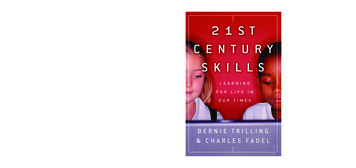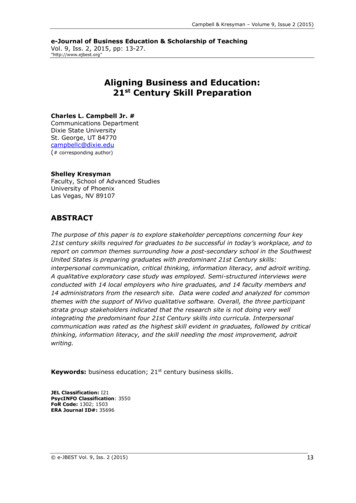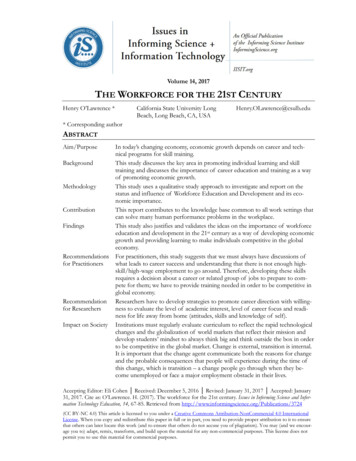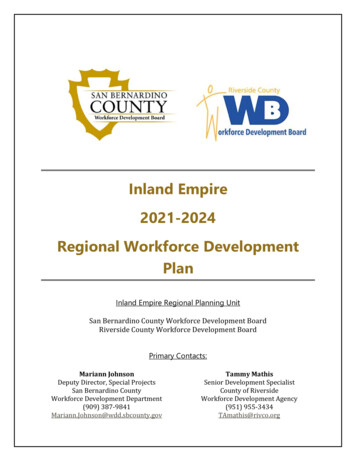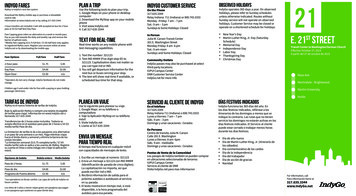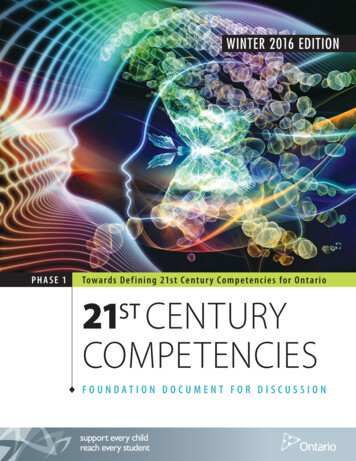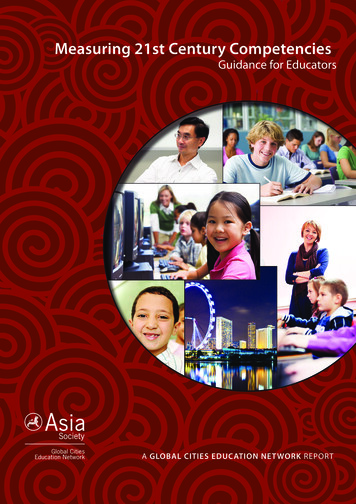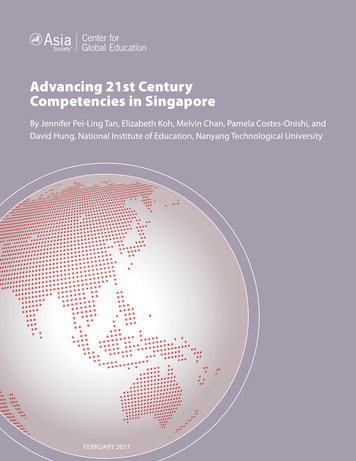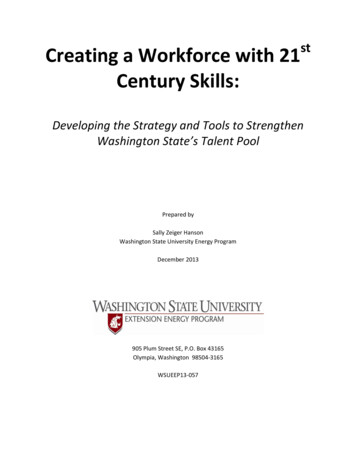
Transcription
Creating a Workforce with 21Century Skills:stDeveloping the Strategy and Tools to StrengthenWashington State’s Talent PoolPrepared bySally Zeiger HansonWashington State University Energy ProgramDecember 2013905 Plum Street SE, P.O. Box 43165Olympia, Washington 98504-3165WSUEEP13-057
Publication DetailsAbout the WSU Energy ProgramThe Washington State University (WSU) Energy Program is a recognized leader in energy research,development and technology transfer. The WSU Energy Program works with government agencies,power marketers, utility consortiums, educational institutions, private businesses and industries onprojects that promote energy conservation, research, development of renewable energy sources, andeconomic and workforce development.AcknowledgementsThe author would like to thank the many contributors and reviewers for their support in the design,review and completion of this project. Special thanks to Alan Hardcastle (WSU), Kyra Kester (WSU),Barbara Hins-Turner (Pacific Northwest Center of Excellence for Clean Energy, Centralia College), JimCrabbe (State Board for Community and Technical Colleges), Todd Currier (WSU) and Tim Probst(Employment Security Department) for their input and reviews of the report. Special thanks to MelindaSpencer (WSU) for editing support.Copyright 2013 Washington State University Energy Program. This publication contains material written andproduced for public distribution. Reprints and use of this written material is permitted, provided it is notused for commercial purposes. Please reference by authors and title and credit Washington StateUniversity Energy Program.ii
ContentsPublication Details .iiExecutive Summary.1Define 21st Century Skills for the Workforce . 1Connect Education, Industry and Students: Online Tool and Results Scorecard . 1Communicate with Washingtonians about the New Workplace . 1Introduction .2The Economy: Why Workforce Development Matters Now .3Automation and Outsourcing . 3Skills Mismatch . 5Navigating from School to Work Can Be Challenging. 6Intersection One – Transition from High School . 6Intersection Two – Skill Building . 7Intersection Three – Employment. 7Workplace Expectations are Changing . 8Time is of the Essence . 8Washington’s Plan to Create a 21st Century Workforce is Underway . 13Partners’ Roles in Workforce Development . 14New Skills Needed in the Workplace . 16Learning to Learn. 16Self-Management . 16Intersection of Disciplines . 17Big Data. 17Education 2.0: MOOCS, New Types of Credentials, and Other Disruptive Technology . 19MOOCS . 19New Kinds of Credentials. 22Other Disruptive Technology . 23Western Governors University . 23The Risk of Inaction . 25Menu of Options. 25Determine 21st Century Skills for Washingtonians. 25iii
Industry/Education: Step Into Each Other’s World Early and Often . 27Employer Collaboration by Sector . 31Online Tool to Connect Students and Employers . 31Communicate New Workplace Expectations with Washingtonians . 33Conclusion: What Should Be Done Next? . 34Define 21st Century Skills for the Workforce . 34Connect Education, Industry and Students: Online Tool and Results Scorecard . 34Require Work-Based Learning Opportunities . 34Create an Online Tool. 35Create Results Scorecard for College Programs . 35Communicate with Washingtonians about the New Workplace . 35Figures and TablesFigure 1. Lag Time Between GDP Recovery and Employment Recovery . 4Table 1. Student Achievement Measures, Points that Build Momentum . 15Figure 2. Pros and Cons of MOOCs . 21Figure 3. Earning and Displaying Mozilla Open Badges . 22Figure 4. Khan Academy Map of Knowledge . 23Figure 5. Framework of Skills . 28iv
work-integrated learning opportunities, createan online tool, to connect employers andstudents, and develop a results scorecard forcollege programs which provides information ina single location about graduation rates, andwage and placement rates by program, sostudents can determine which program is mostlikely to help them reach their goals. In additionto helping students with their decision making,a results scorecard would also increase thetransparency and accountability of theeducation system.Executive SummaryWashington has many robust economicdevelopment initiatives underway, and mostrely on the promise of a skilled and educatedworkforce. That makes a purposeful WorkforceDevelopment System essential. We must ensurethat our current and future workforce isprepared not only for our current economicneeds, but for the emerging opportunitiesforecast to require new and different skill sets.This report compiles research about the skillsneeded by the workforce of the future andsuggests some steps that could be taken inWashington state to strengthen our workforcedevelopment system. Recommendations in thisreport include:Communicate with Washingtonians aboutthe New WorkplaceIncumbent workers, students and educatorsneed to be informed about the ways that workis changing. Washington citizens need both theinformation and the tools to manage theircareers. As a skills framework for the workforceis created and online tools are developed, theinformation will need to be shared with thepublic so they can use these tools to prepareand manage their own careers.Define 21st Century Skills for the WorkforceIt will be important for Washington to create aframework that clarifies the skills that areneeded in the workforce. Defining 21st centuryskills needed by the workforce would help jobseekers and incumbent workers understandwhat skills they should be developing andhoning to become – and stay – relevant andresilient in the workforce.In this report, we note that a number of modelscould be used as a starting point. But to makethe framework relevant for Washington’sworkforce, local partners must be convened todefine the skills that will be needed by our 21stcentury workforce.Connect Education, Industry and Students:Online Tool and Results ScorecardTo close the skills gap, educators and employersneed to work more closely together, moreoften. Consistent interaction between thesetwo worlds will help to ensure that education isrelevant to the workplace. There are severalways to establish this connection betweenstudents, educators and employers: require1
IntroductionFour years after the official end of the GreatRecession, Washington’s economy is growing,albeit unevenly. While some parts of the statehave only 4% unemployment, others seemstubbornly stuck in the double digits. Butoverall, unemployment numbers are comingdown and funding for education has stabilizedsomewhat. This is the perfect time to take stockof where we are and to chart a course for thefuture.If Washington chooses to see itshuman capital as a resourceWashington has many robust economicdevelopment initiatives underway, and mostrely on the promise of a skilled and educatedworkforce. That makes a purposeful WorkforceDevelopment System essential. We must ensurethat our current and future workforce isprepared not only for our current economicneeds, but for the emerging opportunitiesforecast to require new and different skill sets.and takes the time tointentionally foster its growth,Washington businesses, familiesand the economy will reapeconomic rewards for manyIn its broadest sense, Workforce Developmentis a process that begins in the very earlieststages of education as students gain their basicskills. Washington’s education community isdeeply engaged in efforts to improve preschoolpreparation, basic skills education, careerreadiness and high school graduation rates forall. This paper focuses primarily on thatsegment of Workforce Development thatfollows, between high school graduation andemployment, and skill upgrade training forworkers who are already employed.years to come.2
machine. The loss of low-skill tasks in manyworkplaces means fewer jobs overall, and theremaining jobs in those workplaces requirehigh-level technical and problem-solving skills.As a result, the level of skills required foremployment has ratcheted up.The Economy: Why WorkforceDevelopment Matters NowWhile there is much talk about the economyrecovering and things getting back to “normal,”it is important to note that the economy hasundergone a structural change that indicatesthat this is the new normal: very lucrativemarkets and stagnant employment levels. Whilethe country’s gross domestic product (GDP)returned to pre-recession levels in 2009, thatwas accomplished with 6 million fewer workersin the workplace (see Figure 1).Automation and other measures to increaseefficiencies, such as computerized inventorymanagement, have increased productivity:creating more outputs without increasinginputs. It used to be a standard economic axiomthat increased productivity would result ineconomic growth. That is no longer the case.Now, instead of efficiencies allowing the samenumber of workers to be freed up to producemore goods, the number of workers can bereduced and still the outputs can increase.Mid-skill, mid-pay jobs that require somecollege but not a degree accounted for 9 of 10of all job losses in the Great Recession.1 Severalinterrelated forces enabled this to happen: Increased automation and increasedproductivity, Continuous change in workplaceexpectations that increased the skillsgaps, and Slowing growth of the population, whichrequires more and different kinds ofpeople to be trained for the workforce.A few years ago, it seemed as if the movetoward efficient, sustainable business practiceswould result in a new class of “green collar”occupations. While industry continues to evolveits practices to be more environmentallyfriendly, the impact has been different thanpredicted. Rather than creating a whole newclass of occupations, the result has been moreof a “greening” of the whole economy. Manyjobs now incorporate green skills and thedemand for those skills will continue to grow.While the work is not new, the approach to it is.Automation and OutsourcingAutomating routine functions is a familiar story,particularly in America's manufacturing sector.2To streamline production and cut costs,repetitive functions have been eitheroutsourced to subcontractors that can performthe tasks less expensively – often overseas – orautomated so they are performed by aFor example, a craftsperson in construction islikely using their traditional skills now to installenvironmentally friendly materials, weatherproofing projects that increase the longevity ofbuildings, and installing sustainable productssuch as solar panels. This greening of theeconomy will create a need for on-goingincumbent worker training to develop the skills1Jaimovich, Nir; Sie, Henry E., The Trend is the Cycle:Job Polarization and Jobless Recoveries, The NationalBureau of Economic Research, 2012.http://www.nber.org/papers/w183342Bland Jr., Gordon R., The Effects of Job Automationon the Economy, University of Old Dominion,Institute of Electrical and Electronic Engineers s-of-JobAutomation-on-the-Economy3
Figure 1. Lag Time Between GDP Recovery and Employment Recovery4
needed to implement more sustainable andefficient work processes.3individual remains unemployed, the harder it isfor him or her to “catch up” with lost wages andthe less chance they have of gainingemployment in the future. Employer bias issometimes a problem for the long termunemployed and older workers. Also, skillsoften erode during times of unemployment.Not being able to find people with the rightskills hurts businesses, as well. Many employershave cited lack of skills in job candidates asbeing responsible for reduced output.6Skills MismatchEven at the height of the recession and at thehighest rate of unemployment, employersreported that they could not fill some of theirvacancies.4 While there was no shortage ofunemployed people ostensibly available andready to work, employers reported that theavailable candidates were apparently notqualified and, thus, not being hired for theavailable jobs.This seems straightforward, but actually thereare differing opinions about what the skills gapis and what it might mean. The commonconclusion is that the applicants must not havethe skills needed for those jobs and, in fact,employers do cite the lack of qualifiedcandidates as a reason for not filling positions.However, other interpretations of this situationmay also make sense. In light of the recentrecession, employers may be reluctant to makethe investment needed to actually hiresomeone unless they find a candidate who is anexact match for the position. Before thisrecession, they might have been more willing tohire someone who was a strong candidate butwould need some additional training.7The difference between the skills available inthe labor pool and the skills required by themarket is referred to as a skills gap. There isalways some skills gap in an economy, but theskills gap now appears to be growing.Skills mismatches continued to rise inalmost all states even after therecession had ended, partly explainingthe stubbornly high unemploymentrate; in fact, Delaware andWashington state experienced adouble-digit percentage increase intheir skill mismatch index in 2010.5Not having the skills to land a job hurtsindividuals and families. The longer anA question that arises when discussing the skillsgap is: “Are the right people really not availableor are employers unwilling or unable to payenough to attract the right people?” It appearsthat, in some cases, both ideas might be true:there are not enough people with the right skills3Green Economy Jobs Report, State of WashingtonEmployment Security Department, cs/special-reports/green-jobs-2011.pdf4Getting Ahead, Staying Ahead: Helping America’sstWorkforce Succeed in the 21 Century, TheSpringboard Project, Business Roundtable, BillGreen, Chair. d, David; Kochan, Thomas; Osterman, Paul,“Who can fix the ‘middle-skills’ gap?” HarvardBusiness Review, December 2012.7Editorial Board, “Don’t Blame the Workforce,” NewYork Times, June 15, lrecommendations-to-strengthen-a/5Estevao, Marcello; Tsounta, Ivridiki, Has the GreatRecession Raised U.S. Structural Unemployment?International Monetary Fund, day/dont-blame-the-workforce.html?partner rss&emc rss& r 105.pdf5
AND there are employers who are unwilling topay what it would take to attract the rightcandidates. According to the 2012 TalentShortage Survey conducted by Manpower,more than half of U.S. companies indicated thatinadequate compensation makes it hard to hirethe right candidates8.clear sign posts that are easy to find and follow.In this approach to thinking about our system,we can identify areas where improved signagewould be helpful.While it may not be completely clear whatcauses the skills gap, it is clear that people arelooking for work and companies are looking tohire, and the two groups are not easily findingeach other. Washington’s workforcedevelopment strategies will benefit fromcontinuing to explore and address the skills gapphenomenon. Transition from high school (decidingwhether or not to attend post-highschool training; assessing and selectingthe appropriate option); Building skills (can be apprenticeship,internship, college, training, entry-leveljob); or Moving directly into employment.The three main intersections on this highwayalong which students move from high school toemployment are:Navigating from School to Work Can BeChallengingIntersection One – Transition from High SchoolThe first intersection is the transition from highschool to a post-secondary learningopportunity. Helping students understand thevalue of pursuing at least some additionaleducation beyond high school is a challenge.Many students say they cannot afford collegeand even if they could afford it, many do notsee the value.The road between high school and fullemployment can be bumpy. In 2012, McKinsey& Company, a global management consultingfirm, conducted a study across nine countriesand 8,000 educators, youth and employers toidentify the components needed to create asystem where people move smoothly fromeducation to employment9. A metaphor used byMcKinsey & Company in that study describesthe school-to-employment process as ahighway. To enter the road of employment,there are three main intersections, each a placewhere people can get “lost.” Theseintersections are where disconnects ininformation occur that cause people to losetheir way. As we know from our own driving,junctions are easy to navigate only if they bear8Even if students leaving high school arecommitted to continuing their educationaljourney, finding the information they need totake the next step can be hard. They encountermyriad questions: What should they study?What jobs will a program lead to? Who offersthat program? Who has a track record ofgraduates having successful employment aftercompleting that program? How will they pay forthat education?ManpowerGroup’s 2012 Talent Shortage SurveyWhile career guidance efforts in Washingtonstate are underway and continuouslyimproving, the available tools mainly helpstudents identify their strengths, learn aboutcareer options and figure out which hortage2012/9McKinsey & Company, Education to Employment:Designing a System That Works, oyment/report/6
offer the programs they are interested in. Thespecific gap in Washington state concernsinformation about college program outcomes.opportunity for work-integrated learning can bebeneficial for students with a range of learningstyles.Currently, colleges do not make graduationrates or wage and employment data availableto the public in a way that is easy to navigate.While there are several sites that attempt toprovide this data there are still gaps in theinformation that is made available. While sometechnical colleges post such information ontheir website by program, other colleges do not.Tracking students to provide such information iscomplicated and there are not currently anyincentives or requirements to provide suchinformation. Prospective students are on theirown to find out which colleges offer whichprograms. Once that information is known, theprogram outcomes are often not available.How, then, do students in Washington decidebetween Program A at one college and ProgramA at another college?The challenge is to use this phase to build theskills that are needed for a viable career. Can alearner be sure that the skills they are learningwill lead to employment? Not always. Thedegree to which various programs and trainingoptions provide the training and experiencethat employers value is sometimes unclear. Inan effort to ensure that this skill-building part ofthe journey is efficient, Washington’s employersand educators need to link this skill-buildingphase closely to employment.Intersection Three – EmploymentThe third intersection in this highway is thetransition into the workforce. Because of theloose linkage between the skill-buildingexperience and the process of becomingemployed, many students get lost at thisjuncture. The closer the connection is betweeneducation and employment, the smoother thistransition will be. If students have accurateemployment information when they select theirarea of study; have accurate information aboutwhat skills to develop while in the skill-buildingphase; and have an opportunity for work-basedlearning, internships, mentorships or jobshadow experiences, they may be more likely tomove smoothly into employment.Intersection Two – Skill BuildingIf students successfully navigate the firstintersection and arrive at their chosen post-highschool option, they enter into a skill-buildingphase of their journey. During this phase,students need to learn not only specificcontent, but they are also tasked with becomingeven more effective learners than they were inhigh school. Students who can develop aprocess for on-boarding new skills andinformation are poised to be successful in awork world that demands constant skillupgrades.The earlier that employers get involved withstudents and education, the more success theyreport in finding qualified applicants to fill theirvacancies and the more satisfied students arewith their resulting employment.“Learning to learn” is now considered anessential employment skill. Experiential learningsuch as work-integrated learning, project-basedlearning, and on-line gaming experiencesprovide a platform for learners to practice andimplement the skills they are learning. TheOften, students are on their own to secureemployment after completing an educationalexperience. If their credential, whether degreeor certificate, is valued by employers, then the7
outcomes are good for both the individual andthe organization that makes the hire.other forces compel businesses to be in acontinual state of flux. The result is thatworkers are also in an environment ofcontinuous change that requires nearly nonstop learning and skill upgrades.A tighter linkage between the skill-buildingexperiences and the employers would result ina much higher conversion rate from student toemployee. In lieu of this strong linkage,employers are left to grumble about not findingthe right skills in the labor market andindividuals are left to struggle with under- orun-employment if they do not make thetransition into employment.Because we know that technology and theeconomy are changing, evolving and requiringnew skills faster than we can plan for, newapproaches for workforce development areneeded.Time is of the EssenceIncremental changes to the workforcedevelopment system are not going to occur fastenough to meet the needs of employers in thiseconomy. Because workforce training andeducation systems are tied to annual budgetsand include long-term training programs, theydo not tend to be able to change as quickly asthe businesses they serve. As businesses adaptin response to customer demands andtechnology innovations, these factors can alterwhat businesses look for in prospective hires.The McKinsey study reports that there is adiscrepancy between educators and employerswhen it comes to evaluating how welleducation prepares students for employment.Among educators, 72% report in the McKinseystudy that their students are well prepared forwork. Only 42% of employers indicate thateducation prepared candidates foremployment. When asked about the number ofstudents who were employed within threemonths of completing their education, morethan one-third of educators could not providean estimate. Those who tried overestimated thenumber by 20%. It is important to examine whyeducators do not have a sense of howemployable their students are and it would beinteresting to see how this compares to datafrom Washington educators and employers. Thedisconnect may be due to distant, casual orinfrequent communication among employersand educators. Working to better connect andalign educators and employers could help toimprove Washington’s workforce system.A Call for Disruptive InnovationIn much the same way that “disruptiveinnovation”10 (the introduction of newtechnologies, products or services in an effortto promote change and gain advantage) can beused to disrupt current business and breakthrough existing patterns, Washington will needto consider large-scale, creative interventions tomake a big impact on the workforce system. Acall for disruptive innovation in our systemmeans making large-scale, disruptive, andradical changes that make our workforcedevelopment system more effective. Thisimproved workforce development systemwould effectively prepare a talent pool of newWorkplace Expectations are ChangingThe workplace of the 21st century is constantlychanging, and the rate of that change isaccelerating. Technology improvements,increased global competition, changingconsumer demand, market fluctuation and10Term of art coined by Clayton Christianson,Harvard Business pts/8
themselves as “learning managers.”11 Rapidchange will require workers to use their abilityto learn-to-learn and manage their ownlearning to stay ahead of the curve. Even ifworkers complete their education fully ready towork in their field, the skills and demands oftheir occupation will continue to evolve andeven new graduates may quickly find their skillsare outmoded.employees that includes a broader range ofparticipants than ever before and enablesincumbent workers to effectively manage theircareers across many years and many changes.Examples of disruptive innovation include: Funding the first two years of college foreveryone. Expanding game simulations, work-basedlearning and apprenticeshipopportunities. Participating in Massively Open OnlineCourses (MOOCs), which are proving tobe a disruptive technology in education. Connecting employers and students usinga structured social media platform thatdoes not require intensive staffing. Using summer and quarter breaks to setup work or work-simulation experiences. Using industry professionals for shortterm or substitute teaching assignments. Integrating self-directed learning intocredentials. Bringing students into the design processfor new workforce developmentinitiatives. Creating a results scorecard that allowsstudents to compare college programs’graduation, employment and wageresults in one place. Learning fr
Define 21st Century Skills for the Workforce . toward efficient, sustainable business practices would result in a new class of green collar _ occupations. While industry continues to evolve . l-reports/green-jobs-2011.pdf 4 Getting Ahead, Staying Ahead: Helping America's Workforce Succeed in the 21st Century, The


